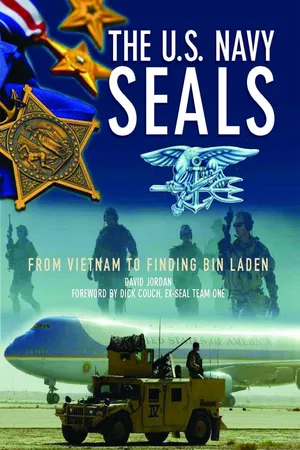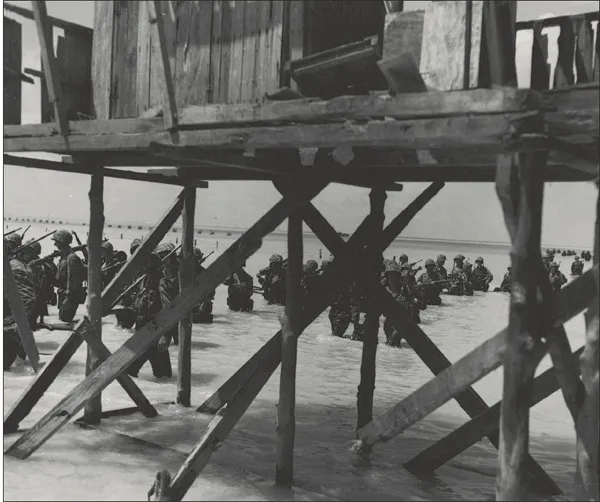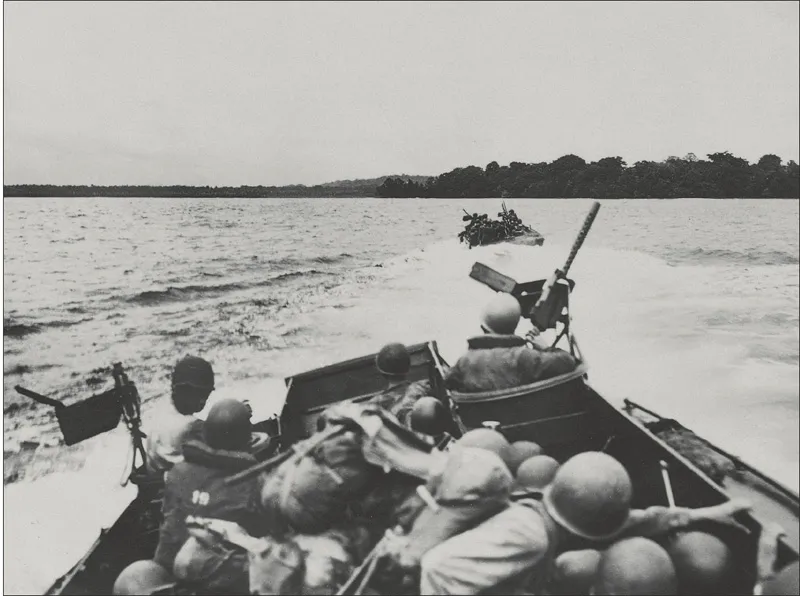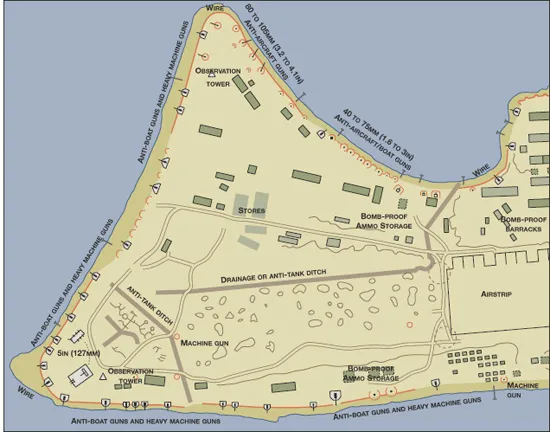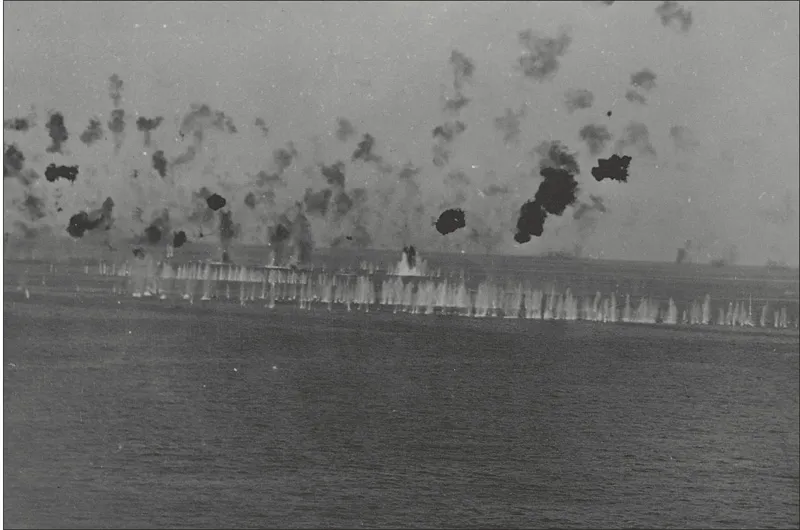![]()
CHAPTER ONE
THE EARLY YEARS
The U.S. Navy SEALs were born in the cauldron of the Pacific War, when the Underwater Demolition Teams were formed to help the Marines land on hostile shores with the minimum of casualties.
Above: On December 7, 1941 the Japanese launched a devastating attack on the U.S. Navy base at Pearl Harbor. Navy divers involved in the rescue and recovery operations at Pearl helped to form the basis for the first U.S. Navy Special Warfare Units.
When the majority of people hear the word “seal” being used, they most frequently think of that mammal which is held in strange affection throughout the world—furry, cute, and usually to be found in the catalogs of soft toy manufacturers. They do not think of something far from cuddly—the U.S. Navy SEAL. He is a very different beast, at home in (or on) the sea, in the air, or on the land—hence SEAL (SEa–Air–Land). The U.S. Navy SEALs are among the finest fighting troops anywhere in the world. They undergo a rigorous selection course that has seen whole classes of would-be SEALs eliminated from the program. They receive intensive and highly realistic training that enables them to operate with equal facility in boats, on land, or parachuting into their target area. They are well armed, very aggressive when the need arises, and incredibly resilient. The SEALs and their predecessors, the Underwater Demolition Teams (UDTs), have served with distinction since World War II. While much of what the SEALs do and have done is still shrouded in the secrecy associated with special forces, there is enough information available to create a picture of what these professional and courageous men do, as the United States’ “tip of the spear.”
The Beginning: Myth and Reality
Popular legend holds that the story of how naval special warfare originated is quite straightforward and runs along the following lines. After the devastating blow sustained in the Japanese attack against Pearl Harbor, the United States waged war on Japan with particular determination. By 1943, the tide had turned against the Japanese. The Battle of Midway had left the Japanese aircraft carrier fleet devastated and the U.S. armed forces had enjoyed other successes, including Guadalcanal and the Battle of the Coral Sea. At the Allied meeting held in Casablanca during January 1943, it was agreed that the defeat of Germany would be the prime objective, ahead of defeating Japan. However, offensive operations in the Pacific were to increase in intensity as well. By the late spring of 1943, planning was well in hand for an amphibious assault on Japanese-held territory sometime in November. The location for the operation was not an easy choice. Initially it was intended that the Marshall Islands should be the first objective but a lack of intelligence information about the defenses was not helpful. Furthermore, the relative proximity of Truk—a well armed Japanese stronghold—meant that the risk of a robust Japanese response could not be ruled out. Finally, although American forces were much stronger than they had been in December 1941, landing ships were in short supply and many of the vessels supporting the invasion were likely to be obsolescent. These factors persuaded the planners that they needed to launch the first assault against a target that could be taken with the resources available at the time. Focus moved from the Marshall Islands to another island group: the Gilberts.
By 1943, the tide had turned against the Japanese. The Battle of Midway had left the Japanese aircraft carrier fleet devastated and the U.S. armed forces had enjoyed other successes, including Guadalcanal and the Battle of the Coral Sea.
At a conference in Hawaii in September 1943, the outline plans were brought together and Operation GALVANIC was approved: the first amphibious operation in the island-hopping campaign would be Tarawa atoll, in the Gilbert island group. The Gilberts had been British-controlled before the war and this meant that the planning teams had access to a large amount of information about the islands from British and Commonwealth expatriates; however, the maps and charts of the area were outdated and unreliable. While aerial photography, reconnaissance by submarines, and the up-to-date knowledge of the “foreign legion” of British, New Zealand, and Australian expatriates could help overcome many of the problems associated with the outdated material, there was one area that could not be dealt with so easily: the tides. It is, of course, axiomatic that tidal conditions are an important consideration in the planning of an amphibious assault but this was particularly true for the Tarawa assault. The first part of the atoll to be attacked was Betio Island and this was surrounded by a coral reef extending some 800–1200 yards (758–1092 meters). While the first waves of attacking troops would be using amtracs (amphibious tractors)—which, by dint of having tracks, could drive across the reef if it was exposed—the succeeding waves would be using what were known as “Higgins boats,” or, in the jargon, Landing Craft, Vehicle Personnel (LCVP). These were shallow-draft vessels, drawing only 3 or 4 feet (91.5 cm–1.2 meters) of water when loaded. If the tides were unfavorable, there would be a serious risk of the LCVPs grounding, leaving their troops with the choices of wading to the beach under fire or transferring to amtracs. While the amtracs were armored and a preferable alternative to wading through the surf, the time taken to offload the men from the Higgins boats to the armored tractors would impose undesirable delay on the arrival of the Marines.
Above: Marines wade ashore at Tarawa in the Gilbert Islands in November 1943. The hazards posed by the coral reefs surrounding the landing beaches were not fully appreciated, and created serious difficulties for the invasion force. This led to an increased emphasis upon beach reconnaissance and obstacle clearing. Since the Marines are coming ashore in tightly bunched groups and with their weapons not at the ready, the picture dates from well after the first landing on Tarawa, which was heavily opposed.
Above: Landing craft head for the shore. The cramped conditions aboard the landing craft are notable. In heavy seas, this made the landing craft an extremely unpleasant environment for those who had not found their sea legs. It also meant that the troops were tightly packed targets for enemy machine gunners once the ramp went down.
Above: An LVT 4 (Landing Vehicle Tracked) or “Amtrac” (short for “armored tractor.”) These amphibious vehicles were extremely useful in both the Pacific and the European theaters.
This was a crucial matter but the planning team was unable to obtain all the information they required. Some of the expatriate advisors thought that while the tides might be a cause for some concern, there would still be enough water to permit the LCVPs to clear the reef. One of the “foreign legion,” Major Frank Holland, disagreed vehemently. He had lived in the Gilberts for 15 years and had studied the tides closely. He argued that the planned date for the assault (November 20, 1943) was the worst one possible, since the tide at that time of the month would give no more than 3 feet (91.5 cm) of clearance over the reef. If his calculations were correct, this would guarantee that the Higgins boats would ground, with all the problems that entailed. But Holland was a lone voice. And as he was in the minority the planners decided that they would, in all probability, not face the difficulties Holland predicted. Being in a minority of one does not make a man wrong, however, and Holland’s worst fears were to be realized when the assault went in on the morning of November 20, 1943.
As early as 0530 hours, it was discovered that a strong southerly current had carried the troopships out of position and within range of Japanese shore batteries. Some sporadic shelling from the enemy positions ended when the ships moved away toward their correct location but it was a poor omen for the landing. A heavy swell delayed the landing craft and H-hour—the time when the first troops were to land—had to be put back. When the first wave finally went in at 0900 hours, the Japanese were startled to see that the attacking craft did not ground on the reef but simply climbed over the coral and carried on toward the shore. However, while the amtracs had no problems with the reef, the same was not true for the Higgins boats. The sea was so low that in places large areas of coral were exposed; in those areas where the water was still covering the reef, it appeared that a depth of 3 feet (91.5 cm) would be the maximum that could be expected. With a terrible inevitability, the LCVPs grounded and the men on board were forced to wade ashore in the face of heavy Japanese resistance. The tanks carried aboard the landing craft had to be let off on the reef’s lagoon edge and some of these disappeared into shell holes, drowning their unfortunate crews. At the end of the first day, the determination of the Marines meant that they were ashore, although the foothold was tenuous. By the end of the fourth day, though, Tarawa had fallen. The casualties were immense. Nearly a third of the Marines landing were killed or wounded on D-Day itself and at one point on November 20, the Marines had sent a signal saying simply “issue in doubt.” By the end of the fighting, more than 3,000 Marines were dead and wounded out of 16,800.
Above: The extent of the on-shore defenses can be appreciated from this view of part of Tarawa. The need for demolitions experts to break through the fortifications was clearly demonstrated in the landings here, and helped lead to the creation of the UDTs.
Above: A barrage of anti-aircraft fire is directed against an incoming Japanese aircraft, in a scene repeated numerous times during the Pacific campaign. The palls of smoke represent airbursts from heavier-caliber weapons. Such intense defenses were essential when dealing with the threat posed by Kamikaze suicide air attacks.
The first American amphibious operation of the war had nearly been thrown back into the sea. Senior officers knew that Tarawa was not unique but the start of a series of such operations in the Pacific. It was also clear that while the war against Germany would be different from that against Japan, it would not be without the need for amphibious operations—not least to return Allied troops to the European continent from their bases in Great Britain—and that specialized troops would be needed to make those amphibious operations possible.
The story of the founding of the UDTs has its roots in the early days of World War II. In fact, it may be said that the origins of the U.S. Navy’s special warfare units can be traced to a time before the United States was even participating in that conflict. We need to begin in about 1939, rather than in the middle of the war. This will allow us to see how beach reconnaissance specialists, underwater demolition experts, and men practiced in the arts of war were necessary to ensure that amphibious forces could reach the shore. This necessity led to the creation of a number of specialist units, some of which were active well before 1943.
THE FOUNDING LEGEND
Returning to Pearl Harbor after the battle, the amphibious fleet commander, Admiral Richmond Kelly Turner, and his staff set about writing the after-action report on Tarawa. Two of Turner’s officers, Captains Tom Hill and Jack Taylor asked for a conference on beach demolitions. Hill and Taylor were developing ideas, though they were still at an early stage. The officers realized that an attempt to breach the coral reef with explosives might have been the answer to the problems faced by the LCVPs if a specialist demolition team had been available. Turner was impressed with the idea and approved their proposals for creating specialized teams to conduct beach reconnaissance, to destroy obstacles, and to guide the amphibious forces ashore. This, so the legend tells us, began the process which gave us the US Navy’s elite SEALs.
Sadly for the hi...
